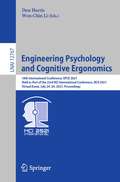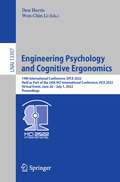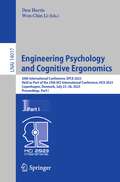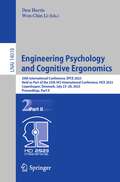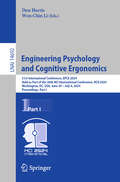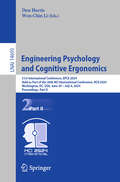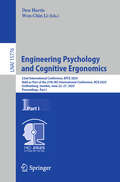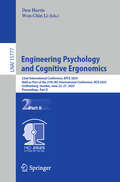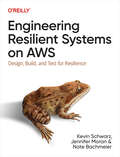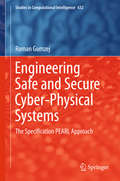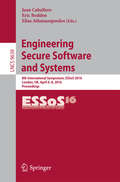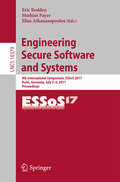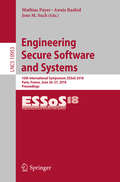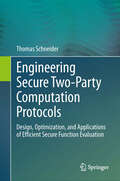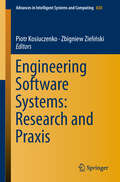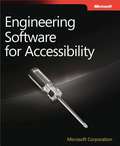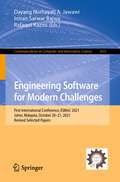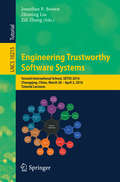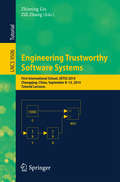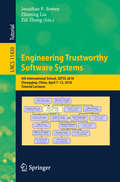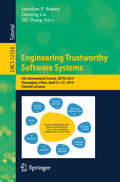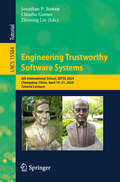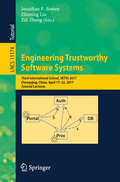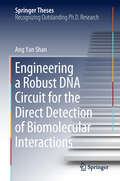- Table View
- List View
Engineering Psychology and Cognitive Ergonomics: 18th International Conference, EPCE 2021, Held as Part of the 23rd HCI International Conference, HCII 2021, Virtual Event, July 24–29, 2021, Proceedings (Lecture Notes in Computer Science #12767)
by Don Harris Wen-Chin LiThis book constitutes the proceedings of the 18th International Conference on Engineering Psychology and Cognitive Ergonomics, EPCE 2021, held as part of the 23rd International Conference, HCI International 2020, held as a virtual event, in July 2021.The total of 1276 papers and 241 posters included in the 36 HCII 2021 proceedings volumes was carefully reviewed and selected from 5222 submissions. EPCE 2021 includes a total of 34 regular papers; they were organized in topical sections named: cognitive psychology in aviation; cognitive psychology in air traffic control; studies on cognitive processes; human error and human performance; and cognition and design.
Engineering Psychology and Cognitive Ergonomics: 19th International Conference, EPCE 2022, Held as Part of the 24th HCI International Conference, HCII 2022, Virtual Event, June 26 – July 1, 2022, Proceedings (Lecture Notes in Computer Science #13307)
by Don Harris Wen-Chin LiThis book constitutes the refereed proceedings of the 19th International Conference on Engineering Psychology and Cognitive Ergonomics, EPCE 2022, held as part of the 23rd International Conference, HCI International 2022, which was held virtually in June/July 2022. The total of 1271 papers and 275 posters included in the HCII 2022 proceedings was carefully reviewed and selected from 5487 submissions. The EPCE 2022 proceedings covers subjects such as advances in applied cognitive psychology that underpin the theory, measurement and methodologies behind the development of human-machine systems. Cognitive Ergonomics describes advances in the design and development of user interfaces.
Engineering Psychology and Cognitive Ergonomics: 20th International Conference, EPCE 2023, Held as Part of the 25th HCI International Conference, HCII 2023, Copenhagen, Denmark, July 23–28, 2023, Proceedings, Part I (Lecture Notes in Computer Science #14017)
by Don Harris Wen-Chin LiThis two-volume set LNCS 14017 - 14018 constitutes the thoroughly refereed proceedings of the 20th International Conference on Engineering Psychology and Cognitive Ergonomics, EPCE 2023, held as part of HCI International 2023 which took place in Copenhagen, Denmark, during July 23-28, 2023.A total of 1578 papers and 396 posters have been accepted for publication in the HCII 2023 proceedings from a total of 7472 submissions. The papers included in the HCII-EPCE volume set were organized in topical sections as follows: Part I: Stress, fatigue, and mental workload; human performance and error management; resilience and performance in demanding contexts. Part II: Human factors in aviation; human factors in operations management; human-centered design of autonomous systems.
Engineering Psychology and Cognitive Ergonomics: 20th International Conference, EPCE 2023, Held as Part of the 25th HCI International Conference, HCII 2023, Copenhagen, Denmark, July 23–28, 2023, Proceedings, Part II (Lecture Notes in Computer Science #14018)
by Don Harris Wen-Chin LiThis two-volume set LNCS 14017 - 14018 constitutes the thoroughly refereed proceedings of the 20th International Conference on Engineering Psychology and Cognitive Ergonomics, EPCE 2023, held as part of HCI International 2023 which took place in Copenhagen, Denmark, during July 23-28, 2023.A total of 1578 papers and 396 posters have been accepted for publication in the HCII 2023 proceedings from a total of 7472 submissions. The papers included in the HCII-EPCE volume set were organized in topical sections as follows: Part I: Stress, fatigue, and mental workload; human performance and error management; resilience and performance in demanding contexts. Part II: Human factors in aviation; human factors in operations management; human-centered design of autonomous systems.
Engineering Psychology and Cognitive Ergonomics: 21st International Conference, EPCE 2024, Held as Part of the 26th HCI International Conference, HCII 2024, Washington, DC, USA, June 29 – July 4, 2024, Proceedings, Part I (Lecture Notes in Computer Science #14692)
by Don Harris Wen-Chin LiThis two-volume set LNAI 14692–14693 constitutes the thoroughly refereed proceedings of the 21st International Conference on Engineering Psychology and Cognitive Ergonomics, EPCE 2024, held as part of HCI International 2024,held in Washington, DC, USA, during June 29 - July 4, 2024. The total of 1271 papers and 309 posters included in the HCII 2024 proceedings was carefully reviewed and selected from 5108 submissions. The papers included in the HCII-EPCE two-volume set were organized in topical sections as follows: Part I: Cognitive Processes and Performance in High-Stress Environments; Decision-Making Support and Automation. Part II: Engineering Psychology and User Experience; Human Factors in Aviation.
Engineering Psychology and Cognitive Ergonomics: 21st International Conference, EPCE 2024, Held as Part of the 26th HCI International Conference, HCII 2024, Washington, DC, USA, June 29 – July 4, 2024, Proceedings, Part II (Lecture Notes in Computer Science #14693)
by Don Harris Wen-Chin LiThis two-volume set LNAI 14692–14693 constitutes the thoroughly refereed proceedings of the 21st International Conference on Engineering Psychology and Cognitive Ergonomics, EPCE 2024, held as part of HCI International 2024,held in Washington, DC, USA, during June 29 - July 4, 2024. The total of 1271 papers and 309 posters included in the HCII 2024 proceedings was carefully reviewed and selected from 5108 submissions. The papers included in the HCII-EPCE two-volume set were organized in topical sections as follows: Part I: Cognitive Processes and Performance in High-Stress Environments; Decision-Making Support and Automation. Part II: Engineering Psychology and User Experience; Human Factors in Aviation.
Engineering Psychology and Cognitive Ergonomics: 22nd International Conference, EPCE 2025, Held as Part of the 27th HCI International Conference, HCII 2025, Gothenburg, Sweden, June 22–27, 2025, Proceedings, Part I (Lecture Notes in Computer Science #15776)
by Don Harris Wen-Chin LiThis two-volume set constitutes the thoroughly refereed proceedings of the 22nd International Conference on Engineering Psychology and Cognitive Ergonomics, EPCE 2025, held as part of HCI International 2025, held in Gothenburg, Sweden, during June 22–27, 2025. Two volumes of the HCII 2025 proceedings are dedicated to this year&’s edition of the EPCE conference. The first volume centers around a diverse array of interconnected themes related to human performance, workload and situational awareness in the use of complex interactive applications and environments, as well as the role of cognitive psychology on designing and evaluating interactive systems and investigating computer-supported as in collaboration and teaming. The second volume focuses on issues related to Cognitive Psychology in the demanding contexts of aviation and space.
Engineering Psychology and Cognitive Ergonomics: 22nd International Conference, EPCE 2025, Held as Part of the 27th HCI International Conference, HCII 2025, Gothenburg, Sweden, June 22–27, 2025, Proceedings, Part II (Lecture Notes in Computer Science #15777)
by Don Harris Wen-Chin LiThis two-volume set constitutes the thoroughly refereed proceedings of the 22nd International Conference on Engineering Psychology and Cognitive Ergonomics, EPCE 2025, held as part of HCI International 2025, held in Gothenburg, Sweden, during June 22–27, 2025. Two volumes of the HCII 2025 proceedings are dedicated to this year&’s edition of the EPCE conference. The first volume centers around a diverse array of interconnected themes related to human performance, workload and situational awareness in the use of complex interactive applications and environments, as well as the role of cognitive psychology on designing and evaluating interactive systems and investigating computer-supported as in collaboration and teaming. The second volume focuses on issues related to Cognitive Psychology in the demanding contexts of aviation and space.
Engineering Resilient Systems on AWS: Design, Build, and Test for Resilience
by Nate Bachmeier Kevin Schwarz Jennifer MoranTo ensure that applications are reliable and always available, more businesses today are moving applications to AWS. But many companies still struggle to design and build these cloud applications effectively, thinking that because the cloud is resilient, their applications will be too. With this practical guide, software, DevOps, and cloud engineers will learn how to implement resilient designs and configurations in the cloud using hands-on independent labs.Authors Kevin Schwarz, Jennifer Moran, and Dr. Nate Bachmeier from AWS teach you how to build cloud applications that demonstrate resilience with patterns like back off and retry, multi-Region failover, data protection, and circuit breaker with common configuration, tooling, and deployment scenarios. Labs are organized into categories based on complexity and topic, making it easy for you to focus on the most relevant parts of your business.You'll learn how to:Configure and deploy AWS services using resilience patternsImplement stateless microservices for high availabilityConsider multi-Region designs to meet business requirementsImplement backup and restore, pilot light, warm standby, and active-active strategiesBuild applications that withstand AWS Region and Availability Zone impairmentsUse chaos engineering experiments for fault injection to test for resilienceAssess the trade-offs when building resilient systems, including cost, complexity, and operational burden
Engineering Safe and Secure Cyber-Physical Systems
by Roman GumzejThis book introduces the concept of holistic designand development of cyber physical systems to achieve their safe and secureoperation. It shows that by following the standards for embedded system'ssafety and using appropriate hardware and software components inherently safesystem's architectures can be devised and certified. While the standardsalready enable testing and certification of inherently safe and sound hardware,this is still not the case with software. The book demonstrates that SpecificationPEARL(SPEARL) addresses this issue and proposes appropriate solutions from theviewpoints of software engineering as well as concrete program components. Bydoing so it reduces the complexity of cyber physical systems design in aninnovative way. Three ultimate goals are being followed in thecourse of defining this new PEARL standard, namely: 1. simplicity over complexity, 2. inherent real-time ability, and 3. conformity to safety integrity and securitycapability levels.
Engineering Secure Devices: A Practical Guide for Embedded System Architects and Developers
by Dominik MerliThis practical guide to building embedded and IoT devices securely is an essential resource for current and future developers tasked with protecting users from the potential threats of these ubiquitous devices.As an engineer, you know that countless devices—from industrial components to smart household appliances—rely on embedded computer systems. But how do you balance the need for robust security with performance and innovative product design?Engineering Secure Devices will guide you through crafting secure devices—from protecting crucial assets to the nature of attackers and the risks they pose. You&’ll explore the technical intricacies and pros and cons of symmetric and asymmetric cryptography and learn how to use and analyze random number generators and cryptographic algorithms. You&’ll learn how to ensure confidential data storage and secure memory, and devise secure device identity solutions and communication protocols to reinforce system architecture against potential threats. And finally, you&’ll learn how to properly design secure boot and secure update processes, manage access control, and perform system monitoring to secure IoT devices.Real-world case studies throughout highlight practical applications, solutions, and obstacles, such as firmware updates with SWUpdate, secure communication with MQTT, and advanced access control with AppArmor.You&’ll also dig into topics like: Analyzing the performance of cryptographic implementations in both hardware and softwareConsiderations for secure boot and software update processes to ensure ongoing firmware integrityDesigning robust device architectures that withstand attacks while maintaining critical operationsDeveloping strategies to detect and respond to anomalies or security breaches in embedded systemsWhether you&’re an IoT developer or an embedded system architect, Engineering Secure Devices equips you with the indispensable knowledge to design, secure, and support the next generation of smart devices—from webcams to four-legged robots.
Engineering Secure Software and Systems
by Juan Caballero Eric Bodden Elias AthanasopoulosThis book constitutes the refereed proceedings of the 8th International Symposium on Engineering Secure Software and Systems, ESSoS 2016, held in London, UK, in April 2016. The 13 full papers presented together with 3 short papers and 1 invited talk were carefully reviewed and selected from 50 submissions. The goal of this symposium, is to bring together researchers and practitioners to advance the states of the art and practice in secure software engineering. The presentations and associated publications at ESSoS 2016 contribute to this goal in several directions: First, by improving methodologies for secure software engineering (such as flow analysis and policy compliance). Second, with results for the detection and analysis of software vulnerabilities and the attacks they enable. Finally, for securing software for specific application domains (such as mobile devices and access control).
Engineering Secure Software and Systems
by Eric Bodden Elias Athanasopoulos Mathias PayerThis book constitutes the refereed proceedings of the 8th International Symposium on Engineering Secure Software and Systems, ESSoS 2016, held in London, UK, in April 2016. The 13 full papers presented together with 3 short papers and 1 invited talk were carefully reviewed and selected from 50 submissions. The goal of this symposium, is to bring together researchers and practitioners to advance the states of the art and practice in secure software engineering. The presentations and associated publications at ESSoS 2016 contribute to this goal in several directions: First, by improving methodologies for secure software engineering (such as flow analysis and policy compliance). Second, with results for the detection and analysis of software vulnerabilities and the attacks they enable. Finally, for securing software for specific application domains (such as mobile devices and access control).
Engineering Secure Software and Systems: 10th International Symposium, ESSoS 2018, Paris, France, June 26-27, 2018, Proceedings (Lecture Notes in Computer Science #10953)
by Awais Rashid Mathias Payer Jose M. SuchThis book constitutes the refereed proceedings of the 10th International Symposium on Engineering Secure Software and Systems, ESSoS 2018, held in Paris, France, in June 2018. The 10 papers, consisting of 7 regular and 3 idea papers, were carefully reviewed and selected from 26 submissions. They focus on the construction of secure software, which is becoming an increasingly challenging task due to the complexity of modern applications, the growing sophistication of security requirements, the multitude of available software technologies, and the progress of attack vectors.
Engineering Secure Two-Party Computation Protocols
by Thomas SchneiderSecure two-party computation, called secure function evaluation (SFE), enables two mutually mistrusting parties, the client and server, to evaluate an arbitrary function on their respective private inputs while revealing nothing but the result. Originally the technique was considered to be too inefficient for practical privacy-preserving applications, but in recent years rapid speed-up in computers and communication networks, algorithmic improvements, automatic generation, and optimizations have enabled their application in many scenarios. The author offers an extensive overview of the most practical and efficient modern techniques used in the design and implementation of secure computation and related protocols. After an introduction that sets secure computation in its larger context of other privacy-enhancing technologies such as secure channels and trusted computing, he covers the basics of practically efficient secure function evaluation, circuit optimizations and constructions, hardware-assisted garbled circuit protocols, and the modular design of efficient SFE protocols. The goal of the author's research is to use algorithm engineering methods to engineer efficient secure protocols, both as a generic tool and for solving practical applications, and he achieves an excellent balance between the theory and applicability. The book is essential for researchers, students and practitioners in the area of applied cryptography and information security who aim to construct practical cryptographic protocols for privacy-preserving real-world applications.
Engineering Software Systems: Research and Praxis (Advances In Intelligent Systems and Computing #830)
by Piotr Kosiuczenko Zbigniew ZielińskiThis book highlights a range of new approaches and concepts in the field of software engineering. Based on systematic methods, graphical and formal models, the approaches are designed for solving practical problems encountered in actual software development. The book is divided into 13 chapters, which address core aspects such as security, performance and quality measurement. Chiefly intended to stimulate new research by presenting real problems faced by the industry, and to facilitate software development by applying precisely defined, validated and efficient models and methods, the book offers a valuable guide – for researchers and industry practitioners at small, medium and large companies alike.
Engineering Software for Accessibility
by Microsoft Corporation<div xmlns="http://www.w3.org/1999/xhtml"><p>Get Microsoft design guidelines for developing accessible Web sites and software. By mapping out your accessible tree and planning for implementation at the specification level, you\u2019ll learn to create products that work with assistive technologies.</p></div>
Engineering Software for Modern Challenges: First International Conference, ESMoC 2021, Johor, Malaysia, October 20–21, 2021, Revised Selected Papers (Communications in Computer and Information Science #1615)
by Imran Sarwar Bajwa Dayang Norhayati A. Jawawi Rafaqut KazmiThis volume constitutes selected papers presented at the First International Conference on Engineering Software for Modern Challenges, ESMoC 2021, held in Johor, Malaysia, in October 20-21, 2021.The 17 papers presented were thoroughly reviewed and selected from the 167 submissions. They are organized in the topical sections on software engineering; intelligent systems; software quality.
Engineering Trustworthy Software Systems
by Jonathan P. Bowen Zhiming Liu Zili ZhangThis volume contains a record of some of the lectures and seminars delivered at the Second International School on Engineering Trustworthy Software Systems (SETSS 2016), held in March/April 2016 at Southwest University in Chongqing, China. The six contributions included in this volume provide an overview of leading-edge research in methods and tools for use in computer system engineering. They have been distilled from six courses and two seminars on topics such as: modelling and verification in event-B; parallel programming today; runtime verification; Java in the safety-critical domain; semantics of reactive systems; parameterized unit testing; formal reasoning about infinite data values; and Alan Turing and his remarkable achievements. The material is useful for postgraduate students, researchers, academics, and industrial engineers, who are interested in the theory and practice of methods and tools for the design and programming of trustworthy software systems.
Engineering Trustworthy Software Systems
by Zhiming Liu Zili ZhangThis volume contains the lecture notes of the five coursesand one seminar given at the School on Engineering Trustworthy Software Systems(SETSS 2014), held in September 2014 at Southwest University in Chongqing,China. The material is useful for postgraduate students,researchers, academics and industrial engineers who are interested in thetheory and practice of methods and tools for the design and programming oftrustworthy software systems. The common themes of the courses include thedesign and use of theories, techniques and tools for software specification andmodeling, analysis and verification. The courses cover sequential programming,component- and object software, hybrid systems and cyber-physical systems withchallenges of termination, security, safety, security, fault-tolerance andreal-time requirements. The techniques include model checking, correctness byconstruction through refinement and model transformations, synthesis andcomputer algebra.
Engineering Trustworthy Software Systems: 4th International School, SETSS 2018, Chongqing, China, April 7–12, 2018, Tutorial Lectures (Lecture Notes in Computer Science #11430)
by Jonathan P. Bowen Zhiming Liu Zili ZhangThis volume contains lectures on leading-edge research in methods and tools for use in computer system engineering; at the 4th International School on Engineering Trustworthy Software Systems, SETSS 2018, held in April 2018 at Southwest University in Chongqing, China.The five chapters in this volume provide an overview of research in the frontier of theories, methods, and tools for software modelling, design, and verification. The topics covered in these chapter include Software Verification with Whiley, Learning Büchi Automata and Its Applications, Security in IoT Applications, Programming in Z3, and The Impact of Alan Turing: Formal Methods and Beyond. The volume provides a useful resource for postgraduate students, researchers, academics, and engineers in industry, who are interested in theory, methods, and tools for the development of trustworthy software.
Engineering Trustworthy Software Systems: 5th International School, SETSS 2019, Chongqing, China, April 21–27, 2019, Tutorial Lectures (Lecture Notes in Computer Science #12154)
by Jonathan P. Bowen Zhiming Liu Zili ZhangThis book constitutes the refereed proceedings of the 5th International School on Engineering Trustworthy Software Systems, SETSS 2019, held in Chongqing, China, in April 2019.The five chapters in this volume provide lectures on leading-edge research in methods and tools for use in computer system engineering. The topics covered in these chapter include Seamless Model-based System Development: Foundations; From Bounded Reachability Analysis of Linear Hybrid Automata to Verification of Industrial CPS and IoT; Weakest Preexpectation Semantics for Bayesian Inference: Conditioning, Continuous Distributions and Divergence; K – A Semantic Framework for Programming Languages and Formal Analysis Tools; and Software Abstractions and Human-Cyber-Physical Systems Architecture Modelling.
Engineering Trustworthy Software Systems: 6th International School, SETSS 2024, Chongqing, China, April 14–21, 2024, Tutorial Lectures (Lecture Notes in Computer Science #15584)
by Jonathan P. Bowen Zhiming Liu Cláudio GomesThis book PSE 15584 constitutes the refereed proceedings of the 6th International School on Engineering Trustworthy Software Systems, SETSS 2024, held in Chongqing, China, in April 14-21, 2024. The 5 full papers and 2 short papers were carefully reviewed and selected from 7 submissions. The proceedings focuses on -Preparatory Course: Introduction to Mathematical Logic and Logic of Programming; -Introduction to Digital Twins -Theories of Contracts and Their Applications -From Automata Models to Validated BCI-Based Cooperative Control On the Viability of Rigorous Approaches to Human-Cyber-Physical Systems of Systems; What Came First, Math or Computing? -What Came First, Math or Computing? -Software Engineering for Explainable AI -Distribution Testing: The New Frontier for Formal Methods
Engineering Trustworthy Software Systems: Third International School, SETSS 2017, Chongqing, China, April 17–22, 2017, Tutorial Lectures (Lecture Notes in Computer Science #11174)
by Jonathan P. Bowen Zhiming Liu Zili ZhangThis volume contains a record of some of the lectures and seminars delivered at the Third International School on Engineering Trustworthy Software Systems (SETSS 2017), held in April 2017 at Southwest University in Chongqing, China. The six contributions included in this volume provide an overview of leading-edge research in methods and tools for use in computer system engineering. They have been distilled from six original courses delivered at the school on topics such as: rely/guarantee thinking; Hoare-style specification and verification of object-oriented programs with JML; logic, specification, verification, and interactive proof; software model checking with Automizer; writing programs and proofs; engineering self-adaptive software-intensive systems; and with an additional contribution on the challenges for formal semantic description. The material is useful for postgraduate students, researchers, academics, and industrial engineers, who are interested in the theory and practice of methods and tools for the design and programming of trustworthy software systems.
Engineering a Robust DNA Circuit for the Direct Detection of Biomolecular Interactions (Springer Theses)
by Ang Yan ShanThis book provides essential insights into designing a localized DNA circuit to promote the rate of desired hybridization reactions over undesired leak reactions in the bulk solution. The area of dynamic DNA nanotechnology, or DNA circuits, holds great promise as a highly programmable toolbox that can be used in various applications, including molecular computing and biomolecular detection. However, a key bottleneck is the recurring issue of circuit leakage. The assembly of the localized circuit is dynamically driven by the recognition of biomolecules – a different approach from most methods, which are based on a static DNA origami assembly. The design guidelines for individual reaction modules presented here, which focus on minimizing circuit leakage, are established through NUPACK simulation and tested experimentally – which will be useful for researchers interested in adapting the concepts for other contexts. In the closing section, the design concepts are successfully applied to the biomolecular sensing of a broad range of targets including the single nucleotide mutations, proteins, and cell surface receptors.
